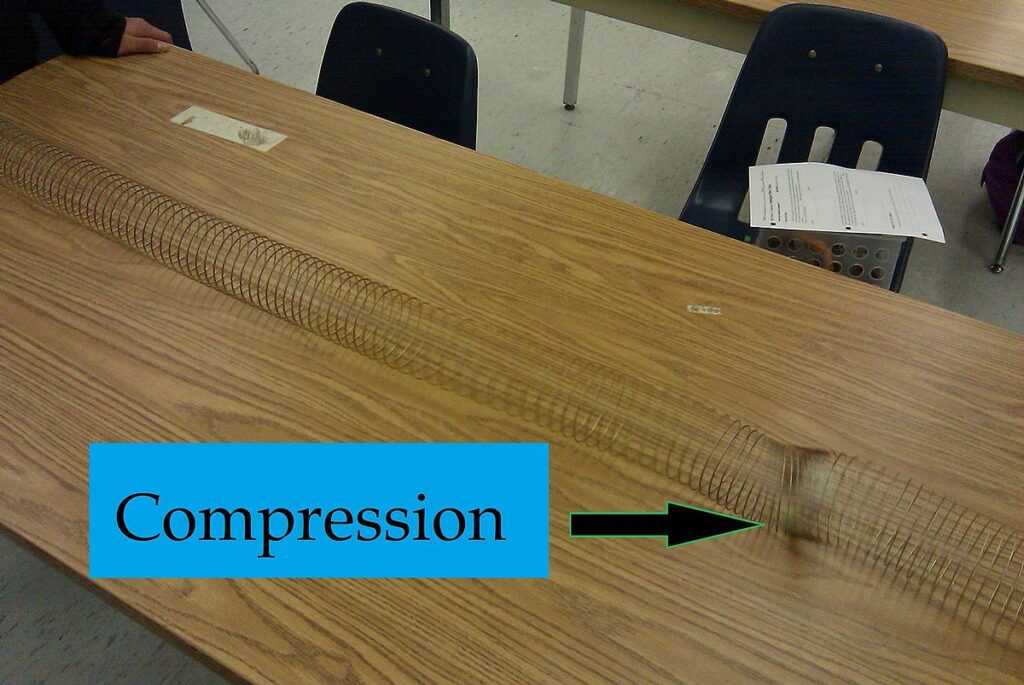We will study in detail how longitudinal waves travel through a vacuum and the detailed explanations in this article.
Longitudinal waves are essential types of mechanical waves that always require a particular medium to travel. But in a vacuum, we can find no such medium that helps the longitudinal waves to propagate. Hence, they cannot travel through a vacuum because of the absence of any matter in it.
Let’s scroll into the article to know can longitudinal waves travel through a vacuum.
Longitudinal wave: Concept and insights
Longitudinal waves are one of the primary types of mechanical waves.
The simple way to define a longitudinal wave is a mechanical wave in which the position of the wave in the medium displaces in the same direction in which the propagation of the wave occurs.
To know the critical propagation medium of longitudinal waves.

Can longitudinal waves travel through a vacuum?
Longitudinal waves cannot move through a vacuum due to the lack of medium required for the propagation.
For any longitudinal wave to propagate, a medium is a must. Since the Vacuum does not contain any medium essential for the propagation of longitudinal waves, it cannot travel through Vacuum.

To understand the concept of movement of longitudinal waves in space.
Why does longitudinal waves cannot travel in space?
Space is a region where the medium will be absent. It is almost similar to Vacuum.
We have already read that longitudinal waves can move or travel only with the help of any medium. If the medium is absent, then it can’t propagate. Since space is similar to Vacuum, longitudinal waves cannot travel through it.
To understand the longitudinal wave propagation through various examples.
Examples of longitudinal waves that help to know the propagation of the wave in Vacuum
The critical longitudinal wave types include sound waves, tsunami waves, spring waves, etc. In detail, we will know why these longitudinal waves cannot travel in Vacuum.
Waves of Tsunami
The waves that hit the seashore during the massive Tsunami are also examples of longitudinal waves. These waves create considerable destruction and cause several damages in the shore regions. Specific media such as air or water are required for these waves to propagate, and the atoms these waves vibrate and propagate in a parallel direction to the wave movement when they reach the shore. Since the Vacuum lacks the medium, longitudinal waves cannot travel in it.

Different sound waves
Sound waves are an actual longitudinal wave example. In general, the sound waves need a specific air medium to propagate and process the information to be heard by someone. The different sounds, such as while speaking, musical instruments, songs, etc., are traveled through a medium. It is the reason these longitudinal waves cannot pass through the Vacuum since it lacks the presence of matter.

Image Credit: Pixabay free images
Waves during earthquakes or pressure waves
The earthquake waves are also widely known as seismic-p waves. It occurs in the inner part of the earth. These waves require a particular medium to travel to the earth’s surface when pressurized. As soon as it reaches the surface with a bit of bump causing destruction, it is considered seismic s-waves. So, it is an actual longitudinal wave example. If there were a Vacuum region inside the earth, it would not have provided the medium that helps the wave travel.

Spring waves
While playing with a spring, certain waves will occur in it, resulting in propagation if you pull its ends. These waves require a specific medium or matter to propagate, and if knocked the spring in Vacuum, then there would be an absence of propagation due to the absence of matter. But in everyday surroundings, the spring waves are considered the best longitudinal wave example.

Conditions affecting the propagation of the longitudinal wave
The essential conditions to be considered in the propagation of waves are that help us to know can longitudinal waves travel through a medium are as follows,
- Presence of medium
- The velocity of longitudinal wave
- Wave impedance
- The density of the medium of propagation
- The rigidity of the medium
To understand the various factors that help in studying longitudinal waves can travel through a medium.
Factors that help in the propagation of longitudinal waves
The different factors of longitudinal waves that help in the propagation through any medium are explained below,
The amplitude of the longitudinal wave
In any longitudinal wave, its amplitude will be considered to be the displacement from any point in the medium from the point of equilibrium.
Compression and Rarefraction of longitudinal wave
Both compression and rarefaction are the essential components of longitudinal waves. In the compression region, the waves are very far from one another, whereas the atoms will be nearer to one another in the compression region.

Period of longitudinal wave
The time for movement of the wave from the displacement of one wavelength is considered the period of a longitudinal wave.
The above given are essential factors to be considered in wave propagation.
Read More: Difference between longitudinal and transverse waves.
Frequently Asked Questions | FAQs
On what medium does a longitudinal wave not travel?
Longitudinal waves can propagate through all types of matter or mediums like solids, liquids, and gases but are prohibited from passing through the Vacuum.
In general, all the longitudinal waves need some medium to propagate. The Vacuum is a medium where we find the absence of any matter that helps the mechanical waves, such as longitudinal waves, pass through it.
On What type of medium can longitudinal waves propagate?
Longitudinal waves can usually pass through all the types of matter that contain a medium.
While these longitudinal waves travel, all the particles present in them vibrate parallel to the wave propagation. The particle can vibrate in the medium, such as solids, liquids, and gases, which help the longitudinal waves to travel through it.
Why can longitudinal waves not travel through a vacuum?
All the vacuum region does not consist of any matter that helps propagation longitudinal waves.
All longitudinal waves need a particular medium to travel or for propagation. But in the case of a Vacuum, there will be the absence of a specific medium that helps the waves pass through it. It is why the longitudinal waves do not travel through any vacuum region.
Do longitudinal waves propagate through a liquid medium?
Longitudinal waves can propagate through all the liquid matter since it allows the particles to vibrate and travel.
A space that contains some matter helps all the types of longitudinal waves to travel through it. So, liquids and fluids are types of matter that surely help them pass through them by vibrating.
In what way do longitudinal waves travel through the air?
Air is one of the kinds of matter in which all the atoms are very loosely arranged together and help the waves propagate through them quickly.
Air provides a medium suitable for any longitudinal waves to pass through it. The atoms vibrate in an air medium in such a direction that it is parallel to the wave propagation; these vibrations are transferred to other atoms in the medium, making the propagation easy.
Also Read:
- Why does energy exhibit wave particle duality
- Energy and wavelength relationship
- Transverse wave vs longitudinal wave
- How to find frequency of transverse wave
- How does a microwave vent work
- What is the speed of a transverse wave
- Types of sound waves
- Why does light exhibit both wave and particle characteristics
- Refraction of waves examples
- How to find the energy of an electromagnetic wave

I am Raghavi Acharya, I have completed my post-graduation in physics with a specialization in the field of condensed matter physics. I have always considered Physics to be a captivating area of study and I enjoy exploring the various fields of this subject. In my free time, I engage myself in digital art. My articles are aimed towards delivering the concepts of physics in a very simplified manner to the readers.